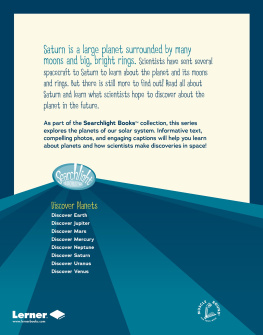Georgia Beth - Stem: The Science of Fitness: Multiplying Fractions
Here you can read online Georgia Beth - Stem: The Science of Fitness: Multiplying Fractions full text of the book (entire story) in english for free. Download pdf and epub, get meaning, cover and reviews about this ebook. year: 2018, publisher: Teacher Created Materials, genre: Romance novel. Description of the work, (preface) as well as reviews are available. Best literature library LitArk.com created for fans of good reading and offers a wide selection of genres:
Romance novel
Science fiction
Adventure
Detective
Science
History
Home and family
Prose
Art
Politics
Computer
Non-fiction
Religion
Business
Children
Humor
Choose a favorite category and find really read worthwhile books. Enjoy immersion in the world of imagination, feel the emotions of the characters or learn something new for yourself, make an fascinating discovery.
- Book:Stem: The Science of Fitness: Multiplying Fractions
- Author:
- Publisher:Teacher Created Materials
- Genre:
- Year:2018
- Rating:3 / 5
- Favourites:Add to favourites
- Your mark:
- 60
- 1
- 2
- 3
- 4
- 5
Stem: The Science of Fitness: Multiplying Fractions: summary, description and annotation
We offer to read an annotation, description, summary or preface (depends on what the author of the book "Stem: The Science of Fitness: Multiplying Fractions" wrote himself). If you haven't found the necessary information about the book — write in the comments, we will try to find it.
Stem: The Science of Fitness: Multiplying Fractions — read online for free the complete book (whole text) full work
Below is the text of the book, divided by pages. System saving the place of the last page read, allows you to conveniently read the book "Stem: The Science of Fitness: Multiplying Fractions" online for free, without having to search again every time where you left off. Put a bookmark, and you can go to the page where you finished reading at any time.
Font size:
Interval:
Bookmark:
0covercover.xhtmlSTEM The Science of fitness Multiplying Fractions Georgia Bethcover1page0001page0001.xhtml22page0002page0002.xhtml33page0003page0003.xhtml44page0004page0004.xhtmlTable of Contents Stronger, Better, Faster 4 Training and Performance 6 Nutrition 14 Training Tools for Athletes 22 The Future of Fitness 27 Problem Solving 28 Glossary 30 Index 31 Answer Key 3255page0005page0005.xhtmlStronger, Better, Faster A swimmer reaches for the wall in record time. An artist stretches across a table as she draws. A family dances as they wash dishes. A firefighter hauls a hose up 10 flights of stairs. A dad lifts his son up to a jungle gym. We all depend on our bodies to perform at their best every day. Around the world, scientists are peering into microscopes. They are reviewing data. Some of them observe world-class athletes as they sprint to the finish line. Others study functional fitness. They are devoted to making it easier for everyday people to lift heavy boxes, run to catch the bus, and play with their dogs. In the lab, on the track, or in the backyard, these scientists strive to understand the human body in new ways. The work they do pushes science forward. In the process, they make people stronger, better, faster. This is the science of fitness. A man performs a fitness test on an exercise bike.66page0006page0006.xhtmlA doctor tests a patient to find out how many calories his body requires while resting.77page0007page0007.xhtmlTraining and Performance Some scientists study how athletes exercise. They observe people in labs where they can control the variables. Variables are things that might change. The temperature in a room might change. Athletes might change what they drink during workouts. Scientists need to control those things to get strong data. Each study gives more information about what it takes to be fit. Scientists might track how much sweat athletes produce. They might focus on how long it takes to complete an exercise. The data makes sports safer. It helps people live longer. It helps people learn how to be healthier. People must train to improve. Whether it's a student studying for a test or an athlete preparing for a big race, practice makes perfect. When it comes to fitness, performance improves when people train. A man does push-ups during his crossfit workout.88page0008page0008.xhtmlTypes of Training Cardiovascular exercise, or cardio, gets hearts pumping hard and fast. It is an aerobic activity. Examples include dancing and biking. Parkour, Zumba, and zombie-inspired marathons keep hearts healthy, too. Cardio also helps people control their weight. It helps people prevent disease. Cyclists, runners, and triathletes all depend on cardio training to improve their bodies' ability to absorb oxygen. Training helps their muscles endure the demands of long races. Parkour includes running, jumping, and climbing city obstacles. LET'S EXPLORE MATH Aerobic exercise increases lung capacity. One way to measure lung capacity is to take a deep breath and blow all the air into a balloon. Then, measure the width of the balloon through its center. The width of Grace's balloon is 6 inches. Keenan fills his balloon 58 as much as Grace does. Is the width of Keenan's balloon greater than or less than 6 inches? How do you know?99page0009page0009.xhtmlAnaerobic exercise is a way to build fitness. It burns fat and strengthens muscles. Strength training is a form of anaerobic exercise. It should be included as part of a complete fitness routine. Many people report that strength training makes them feel more confident. These workouts can even be done with a set of weights or resistance bands. But, your own body weight works well, too. Push-ups, squats, and planks build strength without other equipment. Plyometric workouts push muscles to work hard in short bursts. This form of strength training often includes jumping, hopping, and skipping. Some workouts are aerobic and anaerobic. For example, high- intensity interval training (HIIT) is a popular training method. It mixes intense movement with short periods of rest. The goal is to increase heart rate in cycles. This mix strengthens the heart and lungs. It helps the body gain speed and power, and it gets better results! Another type of exercise that is neither aerobic nor anaerobic is yoga. It still provides a workout. Yoga poses stretch muscles. The moves are usually done on mats. There is even a special yoga mat that works with an app to let people know if they are off balance. Two people add dumbbells to their routine for higher intensity planks.1010page0010page0010.xhtmlLET'S EXPLORE MATH HIIT includes a mixture of activity and rest. During 6 minutes of Reggie's workout, he rests 13 of the time. Use the model to write an equation showing how long he rests.1111page0011page0011.xhtmlAthletes want to improve their performance. But over time, bodies can adapt to training. What was once an intense workout can feel easy. Athletes shouldn't do the same workout each day. It is best to introduce new challenges. New challenges might include trying a new sport. Train harder on some days, and do easier workouts on other days. Take a new class, or exercise with a friend. Push yourself to do something you've never done before. See how your body responds. Experts also recommend that people stretch their muscles before exercising. Stretching helps blood move to muscles where it will be needed. Stretching helps athletes avoid injury so they can keep training. It also improves performance by increasing flexibility, which helps joints move more easily. Prior to stretching, people should jog or walk in place. These activities help muscles warm-up to make stretching safer. Trainers remind their athletes that a workout does not end when the sweat stops pouring. Stretching offers many benefits. Stretching after a workout helps muscle stay long and lean. It can improve performance. It can also help increase blood flow to muscles. An athlete stretches her leg muscles to avoid injury.1212page0012page0012.xhtmlA man jogs prior to stretching.1313page0013page0013.xhtmlRest and Recovery Rest and recovery should be part of any training program. Rest is defined as the time when you are not training. Rest includes time spent sleeping. Sleep is an essential part of a training program. Want to be a stellar athlete? Sleep! Tennis champion Serena Williams goes to bed as early as 7 : 00 p.m. to help her body be at its best. Sleep supports mental and emotional health, too. Recovery includes everything from stretching to reducing stress. Massages, heat wraps, and ice baths are tools that scientifically support the healing process. Drinking water and eating healthy foods help, too. Studies show that exercise causes small tears in muscles. After a workout, the body repairs the tears. This is how muscles get bigger. The process works best when there is time for muscle to rebuild before the next workout. Some athletes train for speed. Others train for endurance. People's bodies need time to recover. Without proper rest, bodies get tired. Workouts may become too difficult. The result may cause a person to lose motivation. It may even lead to injury. Football player Santana Moss takes an ice bath after training.1414page0014page0014.xhtmlLET'S EXPLORE MATH REM sleep is the stage of sleep when dreams occur. It is essential in helping people recover after a workout. 1. Adults spend about 15 of their sleep in the REM stage. How much REM sleep does an adult get in 8 hours? 2. Adults spend about 920 of their sleep in a stage called non-REM light sleep. Is this more or less than the fraction of time spent in REM sleep? How do you know? 3. How much light sleep does an adult get in 8 hours?1515page0015page0015.xhtmlNutrition Food provides energy that athletes need to perform. Top athletes may need a shocking number of calories. Swimmer Michael Phelps once claimed to eat a whopping 12, 000 calories a day when he was training for the Olympics. That's definitely outside of the norm. Doctors recommend that meals consist of a healthy balance of foods. This balance includes filling our plates mostly with fruits and vegetables. These should take up about half of a plate at mealtime. About 14 of the plate should have grains, such as brown rice and whole-grain bread. The last 14 of our plate should include lean protein, such as fish or chicken. Healthy fats and dairy foods should be consumed in small amounts. Healthy fats include nuts and seeds, while dairy products include milk, cheese, and yogurt. Many athletes eat a small meal or snack every few hours. When people eat, their bodies store glycogen. It's the fuel that gives people energy. About 2, 000 calories can be stored at a time. But, some athletes need more fuel. That's why long-distance runners eat extra foods that give them added energy. They may even fuel up during a race with energy gels or sports drinks. Fruits Vegetables Grains Protein Dairy This hiker eats an apple for a healthy snack.1616page0016page0016.xhtmlMichael Phelps This food contains about 12, 000 calories.1717page0017page0017.xhtmlMacronutrients and Micronutrients Every food is a mixture of water, macronutrients, and micronutrients. Carbohydrates, found in grains and fruit, are one type of macronutrient. They give bodies energy. Fats and proteins are also macronutrients. Nuts, avocados, and meat contain fat. Bodies use fat to support brain and bone health. Protein helps people feel full. Muscles use it to stay strong and repair tears. Meat, eggs, and seeds are all good forms of protein. Micronutrients are important. But, they are only needed in small amounts. Micronutrients are vitamins and minerals that help bodies perform. Calcium builds strong bones. Vitamins A and C prevent infections. Iron helps keep bodies strong and provides energy. However, trainers may suggest supplements if an athlete's diet is missing a nutrient. Supplements Top athletes often take supplements to promote their health. Supplements help these athletes get the vitamins and minerals they need without having to eat all day. They might add protein powder to a smoothie or oatmeal. Or, they might take a multivitamin each day. While body builders benefit from protein powder, most people get enough protein from food.1818page0018page0018.xhtml1919page0019page0019.xhtmlVitamin D is another micronutrient. It helps bodies recover. Fish oil is a good source of vitamin D. It contains fatty acids that provide many benefits. It supports heart health. This vitamin also has been proven to help the heart and brain. And, it can even improve your mood. Talk to a doctor before taking supplements. Supplements and vitamins that may seem harmless send about 23, 000 people to the emergency room each year. Some experts also think there is a link between taking too many supplements and a higher risk of developing certain types of cancer. Food Labels The best way to stay healthy is to eat a wide variety of foods. It is important to avoid eating too many foods that have been processed in a factory. They are often loaded with extra sugar. They may have less fiber, too. Fiber is needed to help bodies digest food. Processed foods often lack micronutrients. They may also contain unhealthy types of fats. Food labels show the nutrients in packaged foods. These labels can help you make smart choices. Many people read nutrition facts before buying food.2020page0020page0020.xhtmlThe nutrition facts for an apple tell people how the fruit will fit into their daily meal plan. How does the amount of sugar in the marshmallow candy compare to the amount in the apple?2121page0021page0021.xhtmlWater Did you know that the human body is mainly made up of water? Water is needed for all living things to survive. Water cools the body, helps blood circulate, cushions muscles and joints, and carries nutrients and oxygen to cells. Hydration, or the process of absorbing water into the body, is essential for good health. Dehydration, or the process of losing water from the body, can be dangerous and unhealthy. Without enough water, the body cannot function properly. Breathing, sweating, and urinating all cause the body to lose water naturally. Drinking water is a great way to stay hydrated. Water can also be found in solid foods. Fruits and vegetables, such as cucumbers and strawberries, contain a lot of water. There are a variety of ways to check hydration levels. Clear or pale urine means that someone is fully hydrated. Dark urine often results when people need more water. A sweat sensor is a high-tech method to test whether someone is getting enough water. This sensor, or patch, sticks to the body and records how much sweat is produced. Then, it tells how much water is needed. Adults need to drink about 8 cups (2 liters) of water per day. However, most athletes need to drink 10 to 15 c. (2. 4 to 3. 5 L) of water a day, depending on their training. Athletes need fluids, such as water, to have enough energy to compete. Fluids improve performance and recovery. An athlete wears a sweat sensor that sends data to a smartphone.2222page0022page0022.xhtmlLET'S EXPLORE MATH Tran is a runner. She tracks how much water she drinks to be sure she is fully hydrated. 1. On a training day, Tran drinks 3 liters of water. How many 12 -liter bottles of water does she need to drink to meet her hydration goal? Write a multiplication equation to prove your solution. 2. Tran drinks 14 of a 12 -liter bottle of water as soon as she wakes up. Use the area model to write an equation showing what fraction of a liter she drinks.2323page0023page0023.xhtmlTraining Tools for Athletes There's no doubt that exercise, nutrition, and rest are essential to fitness. But did you know that mental training is also important? Scientists are now studying how athletes can give their minds a workout, too. Fencer Miles Chamley-Watson trains with an app to improve his focus. He uses his brain to control the game. When his brain waves show that he is focused, a character moves across the screen. When he loses focus, the character stays still. The game helps him train his brain to pay attention. This is a good skill to have when a sword is aimed at you! Athletes can also train their minds through meditation. They can focus their minds on an image of themselves having a good game or race. Meditation can help athletes become more aware of their strengths and weaknesses. People who meditate are often more relaxed during stressful situations. They also sleep better and recover faster. Mindfully working out may help even casual fitness fans. Paying attention to each muscle may prevent injury. It can also keep people engaged as they train, helping them enjoy working out more. Fencer Miles Chamley-Watson (left) fights Artur Akhmatkhuzin (right) in the 2016 Summer Olympic Games.2424page0024page0024.xhtmlLET'S EXPLORE MATH Marlene's yoga class is 34 hour long. She meditates for 15 of it. What fraction of an hour does Marlene meditate? Draw an area model and write an equation to show your thinking. This woman sits in the lotus pose, a cross-legged position used in yoga and meditation.2525page0025page0025.xhtmlIt is said that knowledge is power. That might make personal fitness trackers the king of sports. These small devices help people record their activity levels. Fitness trackers have sensors that track movement. Some trackers measure heart rate. A few trackers encourage athletes to meditate. Trackers act as a visual cue to work out and eat healthy foods. At the end of the day, it's easy for a person to see how much they've moved. Fitness trackers are easy to wear around your wrist or on your clothes, and they send data to a smartphone or website. Many gyms use trackers to encourage athletes to compete with one another. Scientists are testing which tracking models work best. Designers are giving them the high-fashion touch, too. But, trackers may soon be invisible. Clear sticky patches could be the next wave of trackers. They will be able to measure everything from blood sugar levels to impact. This may help athletes avoid head injuries. Whatever shape they take, trackers give valuable information to keep people moving. This woman uses her smartwatch to monitor her personal fitness.2626page0026page0026.xhtmlFitness apps are useful for tracking progress. LET'S EXPLORE MATH Lily's goal is to walk 45 of a kilometer without stopping. Every day her new fitness app tracks the fraction of the goal she meets before stopping to rest. How far does Lily walk each day?
Next pageFont size:
Interval:
Bookmark:
Similar books «Stem: The Science of Fitness: Multiplying Fractions»
Look at similar books to Stem: The Science of Fitness: Multiplying Fractions. We have selected literature similar in name and meaning in the hope of providing readers with more options to find new, interesting, not yet read works.
Discussion, reviews of the book Stem: The Science of Fitness: Multiplying Fractions and just readers' own opinions. Leave your comments, write what you think about the work, its meaning or the main characters. Specify what exactly you liked and what you didn't like, and why you think so.















